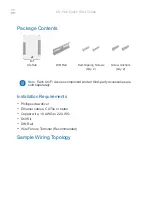
General Circuit Interface (GCI)
17-10
Am186™CC/CH/CU Microcontrollers User’s Manual
Figure 17-4
Bus Activation/Deactivation
17.5.4.1.1
Deactivation
The upstream device typically initiates deactivation. When the Am186CC microcontroller
receives the deactivation request over the C/I channel, it must respond by sending the
deactivation indication over the C/I channel. The upstream device then sends the
deactivation confirmation command over the C/I channel. The Am186CC microcontroller
detects that the clock has stopped (defined as no clock pulse received for 650 ns) and
forces itself to the deactivated state.
In the deactivated state, the microcontroller forces both the DU and DD signals to a high-
impedance state, and monitors the DCL input (by use of the DCLST bit in the GISTAT
register) for any rising edge that would indicate an activation request from the upstream
device.
17.5.4.1.2
Activation
Either the upstream or the downstream device can initiate activation. For the Am186CC
microcontroller to activate the interface, software must set the activation bit (GCIACT) of
the GPCON register. This forces the microcontroller to pull its data output pin (DU) Low,
causing the upstream device to start the GCI clocks. When the clocks are running, as
indicated by the DCLST status bit being set, the microcontroller must respond to the interrupt
by loading the proper C/I command response into the C/I0 transmit register, then clearing
the GCIACT bit. This releases the data output pin (DU) from being held Low and allows the
microcontroller to complete the activation procedure by sending the proper commands over
the C/I channel. The DCL clock remains active until the upstream device stops the clock.
When activation originates from the upstream device, the DCLST bit is set when the clocks
become active (DCL going High). The microcontroller begins normal GCI transmission/
Clock (DCL) received
from upstream; Timing
Request interrupt
generated
Deactivation
Activation Downstream
Activation Upstream
Clocks stopped
by upstream
device
Software clears
Activation bit
Software sets
Activation bit;
DU output forced Low
DU output forced to Z
DD output forced to Z
Time out
(clocks off)
(DU = 0)
(clocks off)
(DU = 0)
(clocks on)
Idle
(clocks off)
(DU = Z)
(DD = Z)
Active
(clocks on)
(DU = data)
Содержание Am186 CC
Страница 1: ...Am186 CC CH CU Microcontrollers User s Manual Order 21914B...
Страница 4: ...iv Am186 CC CH CU Microcontrollers User s Manual...
Страница 18: ...Table of Contents xviii Am186 CC CH CU Microcontrollers User s Manual...
Страница 24: ...Introduction xxiv Am186 CC CH CU Microcontrollers User s Manual...
Страница 39: ...Architectural Overview Am186 CC CH CU Microcontrollers User s Manual 1 15 Figure 1 6 32 Channel Linecard CH CC...
Страница 40: ...Architectural Overview 1 16 Am186 CC CH CU Microcontrollers User s Manual...
Страница 86: ...System Overview 3 36 Am186 CC CH CU Microcontrollers User s Manual...
Страница 92: ...Emulator Support 4 6 Am186 CC CH CU Microcontrollers User s Manual...
Страница 112: ...DRAM Controller 6 8 Am186 CC CH CU Microcontrollers User s Manual...
Страница 134: ...Interrupts 7 22 Am186 CC CH CU Microcontrollers User s Manual...
Страница 186: ...Programmable I O Signals 9 8 Am186 CC CH CU Microcontrollers User s Manual...
Страница 200: ...Watchdog Timer 11 6 Am186 CC CH CU Microcontrollers User s Manual...
Страница 232: ...Asynchronous Serial Ports UARTs 13 24 Am186 CC CH CU Microcontrollers User s Manual...
Страница 242: ...Synchronous Serial Port SSI 14 10 Am186 CC CH CU Microcontrollers User s Manual...
Страница 264: ...High Level Data Link Control HDLC 15 22 Am186 CC CH CU Microcontrollers User s Manual...
Страница 332: ...Universal Serial Bus USB 18 34 Am186 CC CH CU Microcontrollers User s Manual...
Страница 348: ...Register Summary A 16 Am186 CC CH CU Microcontrollers User s Manual...
Страница 376: ...Index Index 18 Am186 CC CH CU Microcontrollers User s Manual...
















































